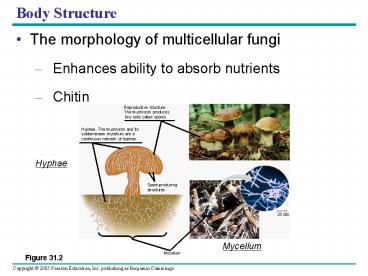Body Structure - PowerPoint PPT Presentation
Title:
Body Structure
Description:
Body Structure The morphology of multicellular fungi Enhances ability to absorb nutrients Chitin Reproductive structure. The mushroom produces tiny cells called spores. – PowerPoint PPT presentation
Number of Views:77
Avg rating:3.0/5.0
Title: Body Structure
1
Body Structure
- The morphology of multicellular fungi
- Enhances ability to absorb nutrients
- Chitin
Hyphae
Mycellum
Figure 31.2
2
Hyphal Structure
- Most are multicellular
- Cells divided by septa
- Some have no cross wall- Coenocytic
Figure 31.3
3
Hyphal Structure
haustoria
Figure 31.4a, b
4
Hyphal Structure
Figure 31.4a, b
5
Mycorrhizae
- Are mutually beneficial relationships between
fungi and plant roots - Mycorrhizae fungus roots
- Delivers minerals and receives organic nutrients
- Ectomycorrhizal fungi Grow in extracellular
spaces of roots - Endomycorrhizal fungi Hyphae go through cell
wall to plasmamembrane
6
Fungus-Plant Symbiosis
- Mycorrhizae
- Increase plant productivity
RESULTS
RESULTS
Figure 31.21
7
Malted barley
8
(No Transcript)
9
(No Transcript)
10
(No Transcript)
11
Saccharomyces cerevisiae
12
- Brewer's yeast tolerate up to about 5 alcohol.
Beyond this alcohol level the yeast cannot
continue fermentation. Wine yeast on the other
hand tolerates up to about 12 alcohol. The level
of alcohol tolerance by yeast varies from 5 to
about 21 depending on yeast strain. - Part 1 Aerobic (Oxygen is present) This is the
initial rapid process where the yeast is doubling
its colony size every 4 hours. (Usually 24-48
hours) - Part 2 Anaerobic. (No oxygen present) Slower
activity and the yeast focuses on converting
sugar to alcohol rather that increasing the
number of yeast cells. (This process can take
from days to weeks depending on the yeast and the
recipe)
13
- The overall process of fermentation is to convert
glucose sugar (C6H12O6) to alcohol (CH3CH2OH) and
carbon dioxide gas (CO2). The reactions within
the yeast to make this happen are very complex
but the overall process is as follows - C6H12O6 gt 2(CH3CH2OH)
2(CO2) Sugar gt
Alcohol Carbon dioxide gas
(Glucose) (Ethyl alcohol) - Note The sugars used can be a range of
fermentable sugars. These sugars are converted by
enzymes to glucose which is then convered to
alcohol and CO2
14
Diploid phase follows karyogamy
- Short-lived (2n) spore-producing structures and
(1n) spores
Ascocarp
Basidiocarp
Sporangia
15
- Concept 31.3 Fungi descended from an aquatic,
single-celled, flagellated protist - Fungi and Animalia as sister kingdoms
- Fungi early colonizers of land, probably as
symbionts with plants.
16
- Concept 31.4 Fungi radiated into a diverse set
of lineages
17
Chytrids
- Found in freshwater and terrestrial habitats
- They can be saprobic or parasitic
- Zoospores unique with flagellated spores
Hyphae
Figure 31.10
18
Zygomycetes
- Fast growing bread and fruit molds
- Can also be parasitic or symbiotic relationship
19
Zygomycetes
Key
Haploid (n)
Heterokaryotic (n n)
Diploid (2n)
PLASMOGAMY
Rhizopus growing on bread
Mating type ()
Mating type ()
100 µm
SEXUAL REPRODUCTION
Dispersal and germination
Zygosporangium (heterokaryotic)
Sporangia
KARYOGAMY
Diploid nuclei
Sporangium
ASEXUAL REPRODUCTION
Zygospore
MEIOSIS
Dispersal and germination
Figure 31.13
Mycelium
50 µm
20
Zygomycetes
- Pilobolus aim their sporangia toward the light
http//www.youtube.com/watch?v9CRNmde0WUcfeature
related http//www.youtube.com/watch?vTrKJAojmB1
Y
Figure 31.14
21
Zygomycetes
- Pilobolus aim their sporangia toward the light
22
Glomeromycetes
- arbuscular mycorrhizae
- See Figure 31.15
http//www.agro-genesis.com/pics/cropscience_rhizo
gold1.jpg
23
Ascomycetes
24
Glomeromycetes
- Spores produced in a saclike asci sac fungi
- Asci are within the ascocarp
25
Basidiomycetes
- Include mushrooms and shelf fungi
- Clublike structure
called a basidium
26
Mushrooms are examples of basidiocarps
Figure 31.20
27
(No Transcript)
28
- Concept 31.5 Fungi have a powerful impact on
ecosystems and human welfare
29
Decomposers
- Essential recycling between the living and
nonliving world
30
Fungus-Animal Symbiosis
- Helping break down plant material
Figure 31.22
31
Lichens
- Symbiotic association of photosynthetic
microorganisms held in fungal hyphae
32
Lichens
- The fungal component
- Is most often an Ascomycete
- Algae or cyanobacteria
- Occupy an inner layer
below the lichen
surface
33
Pathogens
- About 30 of known fungal species
- Are parasites, mostly on or in plants
34
Practical Uses of Fungi
- Make cheeses, alcoholic beverages, and bread
- Genetic research on fungi is leading to
applications in biotechnology - Antibiotics produced by fungi treat bacterial
infections
35
Charophytes
36
Overview The Greening of Earth
- 3 billion years terrestrial surface was lifeless
- Now roughly 290,000
living plant species































